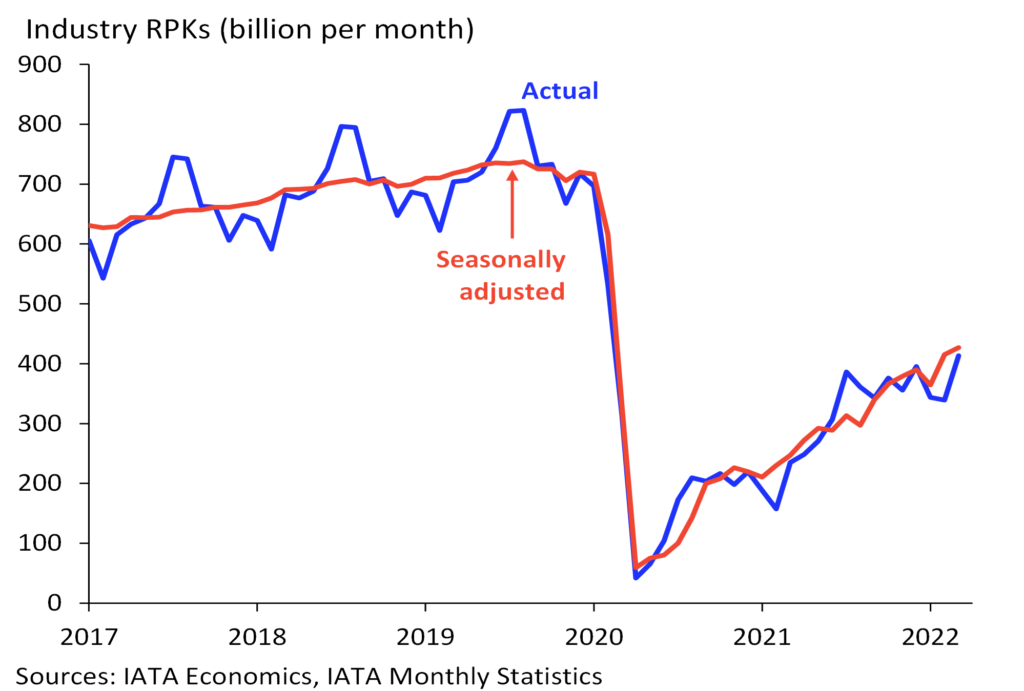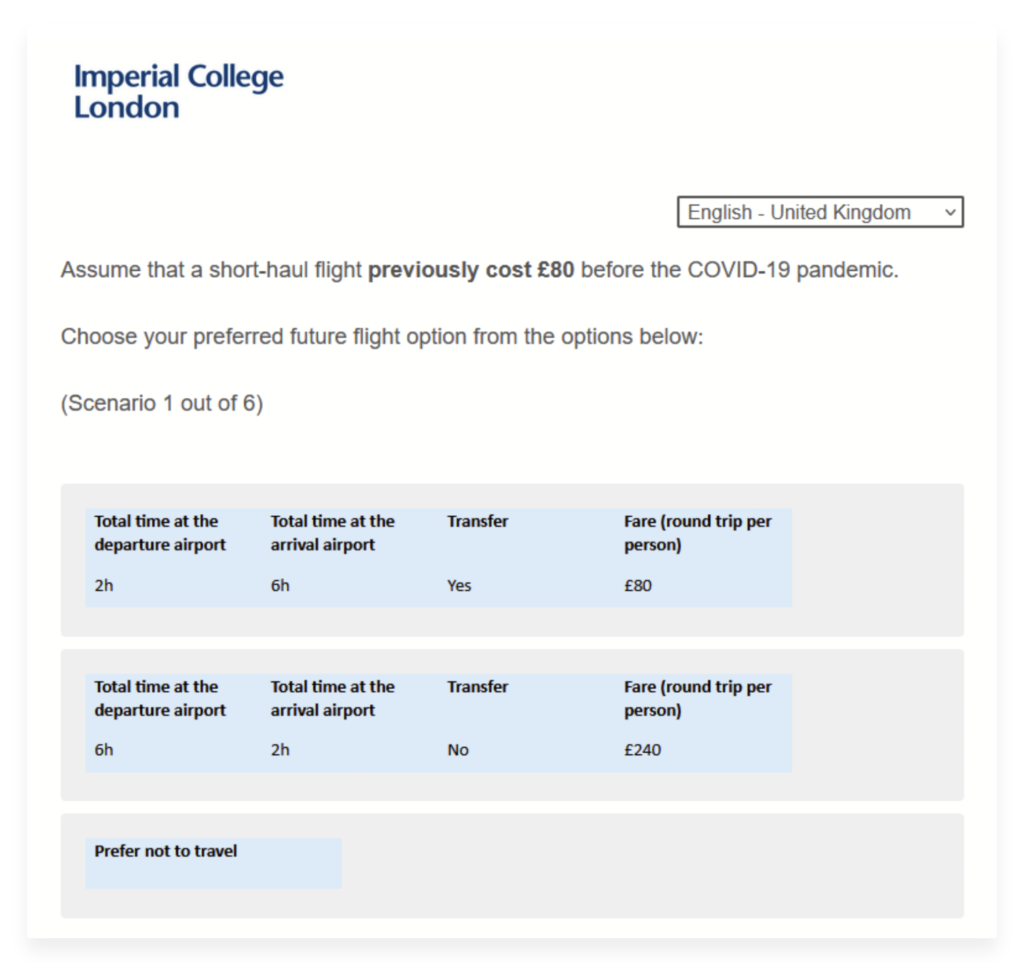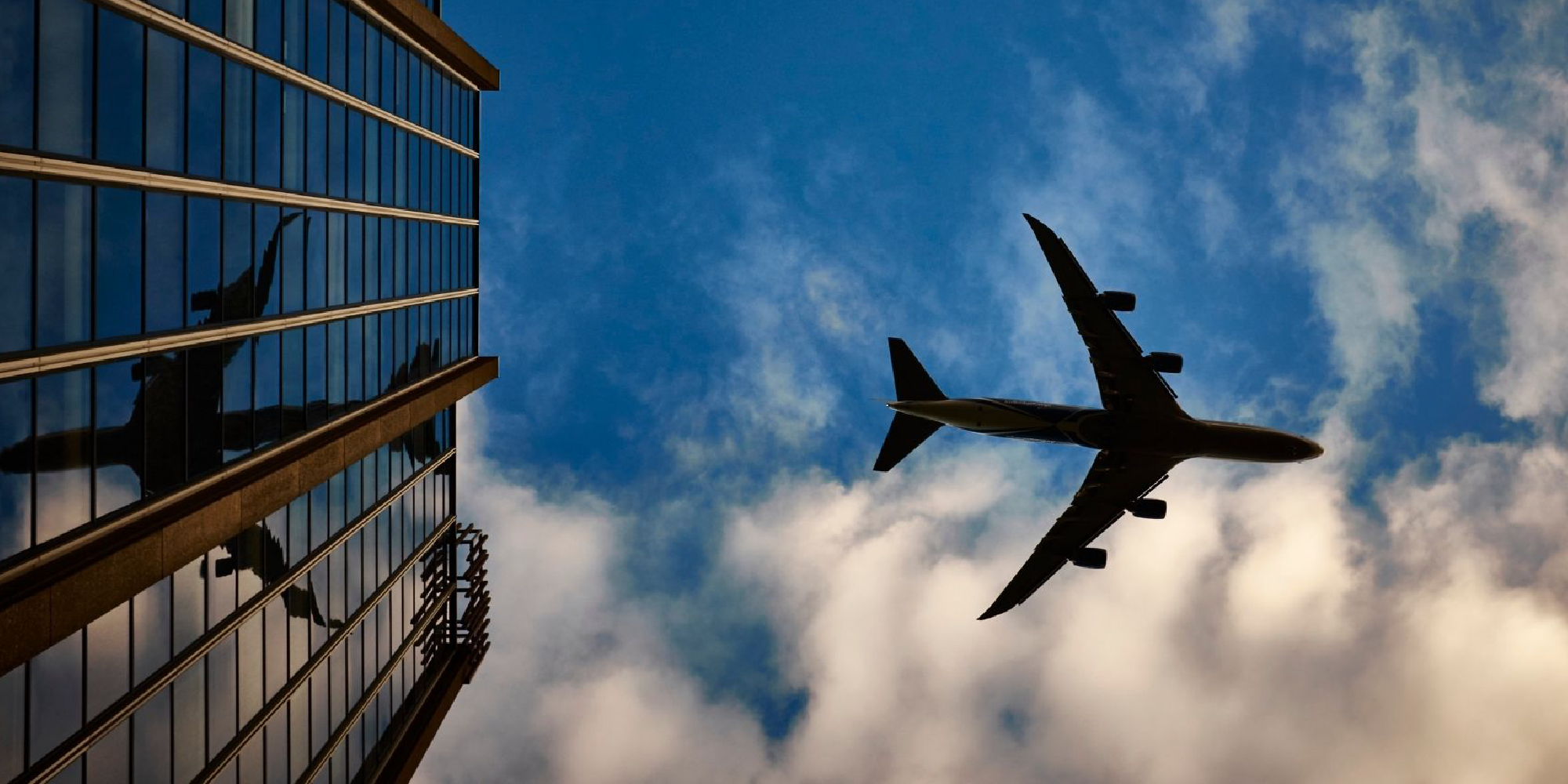The COVID-19 pandemic has affected the transport sector in an unprecedented manner, with the air travel industry subject to some of the most severe and ongoing restrictions in operation. Today, the air transport is still far below where it was prior to the pandemics (see Figure 1).

Changes in the way we travel, restrictions due to emerging situations in the world have not only influenced the transport mode selection and travel comfort, but have also changed attitudes and approaches to long-distance travel. An inherent aspect of the approach to air travel is also the growing awareness of its substantial carbon footprint. At the same time, restrictions on travel have facilitated or even often forced adoption of technology-based means of interaction, including video conferencing, collaboration platforms or online events. This increasingly makes people in various contexts wonder: do we still need and do we still want to fly? Below, we point towards one effort looking at providing suitable evidence whilst also looking at how one goes about conducting such research.
A team of researchers from Urban Systems Lab and Centre for Transport Studies at Imperial College London, led by Dr Aruna Sivakumar and including Dr Jacek Pawlak and Dr Francesco Manca, are looking at shedding light on this question by exploring data collected from from 4 multi-airport cities: London, New York, Shanghai and Sao Paulo as part of a research project ACCLAIM, funded by the UK Engineering and Physical Research Sciences (EPSRC) (Grant EP/M027988/1), the research effort collected survey data. The original motivation for the data collection was to obtain a detailed understanding of air passenger behaviour in terms of willingness to trade between price, flight duration, class of travel, and so on. Such insights were seen as crucial even prior to the pandemic, although stemming from the need to accommodate what was then a continuous growth in the demand for air travel rather than from the need to stimulate the demand. The analysis of the London data is already published (2) whilst the full cross-national comparison is at present under review, but available as a pre-print (4).
Faced with the Covid outbreak, the research team adapted the initial survey to allow investigating the emerging impacts of the pandemics on how people go about air travel, including under the pandemic conditions.
The way in which the researchers approached the problem was via use of an online survey, split in two parts (‘waves’), harmonised across the cities in terms of the number of questions and their content, but suitably translated and adapted to the local contexts, e.g. in terms of the currencies, administrative units of the cities or available airport access (transport) modes.
The first wave of the survey asked the respondents to think back to their last air travel made before January 2020, i.e. just before the initial mobility restrictions were introduced (in China). The respondents were then asked a number of questions that described their travel, including purpose, destination, cost, class of travel, companions, but also some less explored aspects of behaviour, e.g. types of products and services purchased at the airport or while travelling, activities conducted before or during the flight or how productive they felt. In addition, the respondents were asked about their socio-demographic characteristics as well as about their opinions concerning climate change and intention to reduce air travel as a result of such concerns. As the data collected in the first wave represents an actual journey made by the respondent, it can be referred to as ‘revealed preference’ (RP) data, since the traveller revealed their preference for making particular selections from available choices.
The RP nature of the data in the first wave can be contrasted with the second wave which collected the so-called stated preference (SP) data. The SP refers to a mechanism whereby the respondents are asked to consider hypothetical scenarios and state their preference for the available alternatives.

In the current context, the alternatives available to the respondents referred to their original journey (as reported in the RP wave), but with slightly amended attributes, such as price, flight duration or class of travel. For example, the respondent would be asked to state whether they prefer an itinerary which is more expensive but involves a direct flight or whether they would prefer a cheaper option but with a stopover. Figure 2 shows an example of the survey as presented to a respondent reporting travel from London to Warsaw in December 2019. With appropriate statistical design, specific combinations of the attributes are selected so as to minimise the respondent burden (i.e. number of questions) while allowing subsequent econometric analysis and modelling to be robust.
Given the Covid-19 context, the research team designed two scenarios. In the first one, the respondents were asked to consider a similar context to that before the pandemic. In the second scenario, the respondents were asked to imagine a situation where Covid-19 is still in circulation, though restrictions on mobility are lifted and effective vaccines are available. In the latter scenario, the respondents were also given the possibility to not travel.
This consideration, alongside questions concerning the use of videoconferencing software as well environmental attitudes allowed the researchers to form a novel perspective on how, and indeed whether, people may choose to travel by air as the world adjusts itself to the post-pandemic reality.
The research team analysed the data using techniques that are collectively known as discrete choice modelling (DCM). DCM is a set of mathematical tools that attempts to link how selection of discrete, i.e. finitely countable, alternatives depends on their attributes as well as on attributes of the decision maker. The classical and intuitive application transport mode choice, e.g. between walk, bus, train, car, depending on duration and cost of travelling while also accounting for the traveller’s characteristics. In addition, DCM permits also investigating the impact of factors that may not be directly observable (‘latent’), such as those related to fear of catching Covid-19 or concerns in relation to being quarantined. Overall, the DCM techniques are widely used in the context of analysis of transport systems and travel behaviour, but also beyond e.g. in sociology, psychology, economics, market research or public health. In fact, the 2000 Nobel Prize was awarded to Daniel McFadden and James Heckman for their extensive contributions to development of this field of analysis.
The analysis revealed a common pattern across the investigated cities. Before the pandemic, more than half of the respondents barely or did not at all use video-conferencing. During the pandemic, the trend was reversed with the share of respondents stating their use of video-conferencing to be ‘Several times a week’ increasing the most. This confirms that physical interaction has been replaced by high-frequency virtual interaction. Interestingly, when asked about the potential use of virtual meetings in place of flying in the post-pandemic future, respondents in London and New York leaned towards an expectation that they would go back to the pre-pandemic levels of flying to in-person meetings. In contrast, respondents from Shanghai and Sao Paulo revealed a stronger sentiment that video calls will be used much more than before. Nonetheless, in all cities, about 40% of respondents shared an expectation that they will fly less in the future.
Analysing further these results, the researchers tried to find out reasons for differences in preferences towards travelling or not in the post-Covid reality. One of the routes to find the answers was to look for differences in what exactly people are concerned about Covid, when they make decisions about air travel. For example, in London and Sao Paulo, respondents would be less willing to travel out of fear of catching Covid-19 themselves, meeting careless travellers (London only), or passing the virus to family and friends (Sao Paulo only). In New York, these effects were less pronounced though the researchers observed that travellers who feel safer while wearing face-masks’ while travelling or having empty seat next to them were also less likely to travel at all. Finally, the respondents from Shanghai indicated that it was the dislike of quarantine that would discourage them from travelling by air. The researchers argued that sources for such different perceptions could result from cultural differences. For example, past studies (3) have shown that Brazilian society leans towards so-called social collectivism, i.e. a high degree of integration in cohesive groups such as extended family. As a result, their concern about Covid extends beyond themselves and into the family, which is in contrast to more individualistic cultures, e.g. of the US or the UK. Interestingly, the researchers found respondents from Shanghai to be more similar in that respect to those from London and New York, than Sao Paulo.
At present, the researchers are also looking at ways in which the environmental attitudes of the travellers may play a role in the decision-making in relation to air travel. The results so far indicate again that respondents differ across the cities. For example, Shanghai travellers appear to be more ready to drop air travelling now whilst there appears to be no link between level of environmental concern and air travel intentions among New York travellers. But the most interesting pattern is observed in London and Sao Paulo, where respondents intend to maintain their current air travel habits in the near future despite the environmental concerns and address the environmental impact, e.g. via carbon offsetting schemes, while also considering a change in the travel habits in the longer term.
Coming back to the original question of whether we still need and want to fly. It appears so far that the change in the form of meetings to remote meetings was felt most by employees travelling on business. The research points towards the conclusion that frequent use of virtual platforms for business meetings, intensified the desire to return to live meetings and business travel whenever possible. It is very possible that the increased desire to travel is simply due to the saturation of online meetings, whereas “past states” (i.e. whether video calls were used before the pandemic) are too distant to be relevant. The desire to travel is partly observed nowadays, with the rebound in air demand even if still below the pre-pandemic levels.
This conclusion gives a positive outlook for the airline industry, for which business travel accounted for about 75% of airline profits. At the same time, the growing awareness of the impact of air travel on the environment may gradually emerge as an important factor in decision-making concerning air travel. The pace and nature of that impact will be different across the markets, and airlines will need to react accordingly, by tailoring their offers. The competition from other modes of travel may also enter the piecure, e.g. high speed rail for short and medium distances. Nonetheless, the outlook for either sectors is clearly disrupted by high and volatile fuel prices as well as geopolitical uncertainty. Could these factors be fuelling another wave of shifts from air travel to online meetings? This remains to be seen, whilst researchers like Dr Pawlak and others from Urban Systems Lab and Centre for Transport Studies at Imperial College London continue to seek answers that can hopefully assist the air travel sector, including the passengers, in managing their air travel expectations and preferences in the upcoming years.
For more insights on the topic, please check:
- IATA, Air Passenger Market Analysis March 2022, Air travel sustains positive trend in March, https://www.iata.org/en/iata-repository/publications/economic-reports/air-passenger-monthly-analysis—march-2022/, 13.05.2022
- Francesco Manca, Aruna Sivakumar, Jacek Pawlak, Norbert J Brodzinski Urban Systems Lab, Centre for Transport Studies, Department of Civil and Environmental Engineering, Imperial College London, London, U.K
https://journals.sagepub.com/doi/full/10.1177/03611981211025287 - Beekun, Rafik I, Yvonne Stedham, and Jeanne H Yamamura. 2003. “Business ethics in Brazil and the US: A comparative investigation.” Journal of Business Ethics 42 (3):267-279.
- Manca, Francesco and Pawlak, Jacek and Sivakumar, Aruna, Impact of Perceptions and Attitudes on Air Travel Choices in the Post-COVID-19 Era: A Cross-National Analysis of Stated Preference Data (November 1, 2021). Available at SSRN: https://ssrn.com/abstract=4106695
Joanna Rancew



